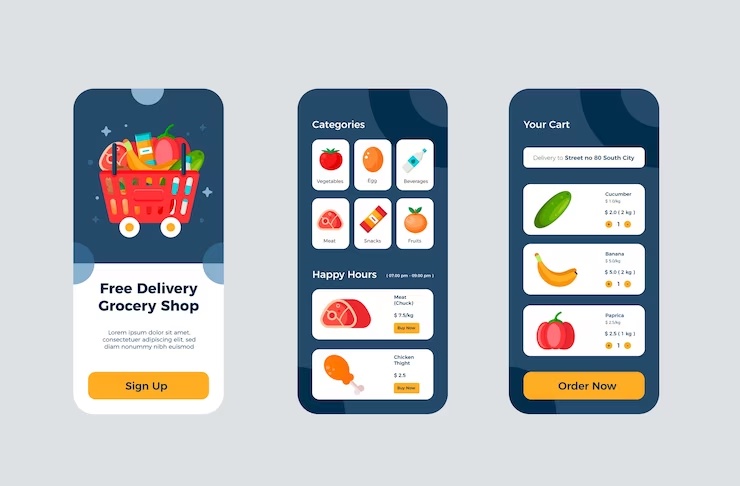In today's fast-paced world, grocery delivery apps have become an essential part of modern convenience. As more consumers turn to online platforms for their shopping needs, the success of a grocery delivery app hinges on a combination of user-friendly features that enhance convenience, selection, efficiency, and overall user experience. Here are some key features that contribute to the success of a grocery delivery app:
-
Intuitive User Interface (UI): A clean and intuitive UI is crucial for attracting and retaining users. The app should be easy to navigate, with well-organized categories, clear product images, and a straightforward checkout process. Intuitive design reduces user frustration and encourages engagement.
-
User Personalization: Offering personalized recommendations based on user preferences, past purchases, and browsing history enhances the shopping experience. Tailored product suggestions make it easier for users to discover new items and add them to their carts, thereby increasing order value.
-
Robust Search and Filters: An efficient search bar and advanced filters are essential for users to quickly find the products they need. The search function should accommodate different variations of product names and provide relevant results. Filters based on categories, brands, dietary preferences, and pricing help refine search results.
-
Comprehensive Product Descriptions: Detailed product information, including images, descriptions, ingredients, nutritional facts, and customer reviews, helps users make informed decisions. High-quality images and accurate descriptions replicate the in-store experience.
-
Real-time Inventory Updates: Displaying real-time stock availability prevents users from ordering items that are out of stock. Incorporating a system that removes or indicates low-stock items can reduce customer disappointment.
-
Multiple Payment Options: Offering a variety of payment methods, such as credit/debit cards, digital wallets, and online payment platforms, caters to different user preferences. Additionally, integrating secure and seamless payment gateways instills trust in users.
-
Flexible Delivery Scheduling: Allowing users to choose convenient delivery time slots enhances the app's appeal. This feature accommodates varying schedules and ensures that groceries arrive when users are available to receive them.
-
Geolocation and Tracking: Seamless integration of geolocation services enables users to track their orders in real-time. Sharing the delivery driver's location and estimated arrival time minimizes uncertainty and allows users to plan accordingly.
-
Order History and Favorites: Storing past orders and enabling users to create a list of favorite items simplifies future shopping trips. This feature enhances user convenience and encourages repeat purchases.
-
Promotions and Discounts: Push notifications or a dedicated section for ongoing promotions, discounts, and deals encourage users to explore new products and make cost-effective choices.
-
Customer Support: In-app chat or customer support helpline assists users in case of order issues, product inquiries, or technical glitches. Responsive customer service enhances user satisfaction and loyalty.
-
Rating and Reviews: Allowing users to leave reviews and ratings for products helps build trust and transparency. Positive reviews can influence purchasing decisions, while constructive feedback aids in product improvement.
-
Multi-platform Availability: A successful grocery delivery app should be available on multiple platforms, including smartphones and tablets, to cater to a diverse user base.
-
Security and Privacy: Emphasize the app's commitment to data security and user privacy. Implement strong encryption for payment information and assure users that their personal data won't be shared without consent.
-
Integration with Loyalty Programs: For users who frequent the app, integrating with loyalty programs or rewards systems can incentivize repeat business.
-
Efficient Backend Management: A robust backend system is essential for managing orders, inventory, and delivery logistics smoothly. It ensures that the app remains responsive even during peak usage times.
-
Social Sharing: Enabling users to share their shopping experiences or favorite products on social media can lead to organic growth and word-of-mouth marketing.
-
Localization: If the app serves a global or diverse audience, localization features like language options, currency conversion, and region-specific offerings should be included.
-
Feedback Mechanism: Providing users with the ability to offer feedback directly within the app can help you continually refine and improve its features.
-
Seamless Integration with Third Parties: Integrating with local grocery chains, farmers markets, and specialty stores expands product variety and attracts a wider user base.
Conclusion,
In successful grocery delivery app development hinges on a combination of convenience, personalization, ease of use, and reliable features that cater to modern consumers' needs. By incorporating these key features, you can create an app that not only meets user expectations but also sets the foundation for long-term success in the competitive online grocery market.


No comments yet